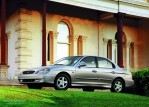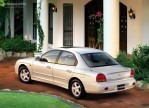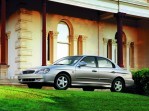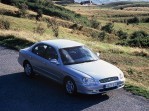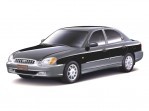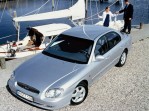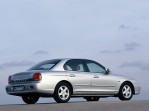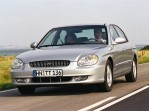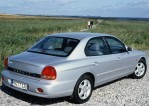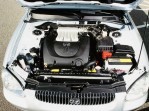Segment: Medium
Production years: 1998, 1999, 2000, 2001
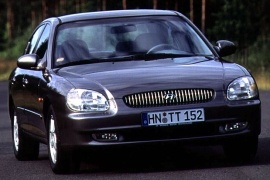 12 Photos
12 PhotosHyundai rushed the Sonata through generations, and in 1998, thirteen years after the nameplate was introduced in the automaker’s inventory, the car had already reached its fourth generation.
The Korean automaker pushed its R&D departments harder than many other car manufacturers in the world. In 1983, Hyundai was making vehicles based on Mitsubishi’s platforms and engine but aimed to be in the top ten of the automotive industry. Meanwhile, its engineers learned how to create reliable and potent engines that were on par with what other brands could provide. Furthermore, the investment into new platforms led to the Y4 version, on which the fourth generation of the Sonata was based. However, the styling department looked like it was funded with lunch money, so the overall look of the vehicle wasn’t that appealing to customers.
At the front, the 1998 Hyundai Sonata followed the bio-design trend, which was about to be canceled by other automakers. Its triangular, corner-mounted headlights, with shaved edges and corners, looked like they were melting. Between them, the automaker placed a narrow grille with vertical slats where the H-badge took center stage. Lower, the wrapped-around plastic bumper had an additional air intake in the apron flanked by available fog lamps.
From its profile, things didn’t go too well either. It was a form-follow-function concept that led to a tall greenhouse in the middle of the vehicle. The brand’s stylists tried to enhance the look of the 1998 Hyundai Sonata with a few creased lines on the front and rear fenders and the rear doors. Inexplicably, they didn’t consider continuing it over the front doors as well. However, the overall shape wasn’t bad at all, but it couldn’t earn any gold medal at a design contest, especially due to the rear side of the car. There, Hyundai installed taillights that echoed the headlights’ shape, which was a good thing, but they flanked a satin-chromed slat adorned by the Sonata lettering on the trunk’s lid. It looked appropriate only on light-colored vehicles.
For the car’s interior, Hyundai created a more pleasant cabin with enough room for the front occupants. The dashboard had smooth shapes, and the instrument cluster that fronted the driver was seamlessly continued by the center stack. Hyundai understood that its customers would take vehicles fitted with enough features to make their lives better and forget about the exterior design. As a result, all versions came well-equipped with stereo, air conditioning, power windows and locks, and pretty much everything a driver and its passengers needed. Furthermore, for the upper grades, the automaker installed leather seats, wood trims (although made from plastic), and automatic climate control. In the back, the bench seat was appropriate for three passengers thanks to the 2.7-meter (106.3-in) wheelbase, but the center tunnel that crossed the vehicle front to back limited legroom for the middle-seated one.
Under the hood, Hyundai offered the car with a choice of in-house developed two gasoline engines paired with a five-speed manual or a four-speed automatic, depending on the market. However, the most significant upgrade brought by the Y4 platform to the Sonata range was the introduction of the double-wishbone front suspension, which was far better than the previous McPherson one. At the back, the comfortable ride was ensured by the multi-link system, which was carried over and enhanced from the Sonata’s third generation.
HYUNDAI Sonata 1998, 1999, 2000, 2001
- 2.0i 5AT FWD (136 HP)
- 2.0i 5MT FWD (136 HP)
- 2.5i V6 5AT FWD (160 HP)
- 2.5i V6 5MT FWD (160 HP)
HYUNDAI Sonata
2.0i 5AT FWD (136 HP)
ENGINE SPECS - 2.0i 5AT FWD (136 HP) | |
|---|---|
| Cylinders: | L4 |
| Displacement: | 1997 cm3 |
| Power: | 100 KW @ 5800 RPM 136 HP @ 5800 RPM 134 BHP @ 5800 RPM |
| Torque: | 133 lb-ft @ 4600 RPM 180 Nm @ 4600 RPM |
| Fuel System: | Multipoint Injection |
| Fuel: | Gasoline |
| Fuel capacity: | 17.2 gallons (65.1 L) |
PERFORMANCE SPECS | |
|---|---|
| Top Speed: | 118 mph (190 km/h) |
| Acceleration 0-62 Mph (0-100 kph): | 10.5 s |
TRANSMISSION SPECS | |
|---|---|
| Drive Type: | Front Wheel Drive |
| Gearbox: | 5-speed automatic |
BRAKES SPECS | |
|---|---|
| Front: | Ventilated Discs |
| Rear: | Discs |
TIRES SPECS | |
|---|---|
| Tire Size: | 195/70R14 |
DIMENSIONS | |
|---|---|
| Length: | 185.4 in (4709 mm) |
| Width: | 71.7 in (1821 mm) |
| Height: | 55.5 in (1410 mm) |
| Front/rear Track: | 60.6/59.8 in (1,539/1,519 mm) |
| Wheelbase: | 106.3 in (2700 mm) |
| Ground Clearance: | 5.9 in (150 mm) |
| Cargo Volume: | 14 cuFT (396 L) |
| Aerodynamics (Cd): | 0.32 |
WEIGHT SPECS | |
|---|---|
| Unladen Weight: | 2857.2 lbs (1296 kg) |
| Gross Weight Limit: | 4210.8 lbs (1910 kg) |
FUEL ECONOMY (NEDC) | |
|---|---|
| City: | 18 mpg US (13.1 L/100Km) |
| Highway: | 33.1 mpg US (7.1 L/100Km) |
| CO2 Emissions: | 213 g/km |
HYUNDAI Sonata
2.0i 5MT FWD (136 HP)
ENGINE SPECS - 2.0i 5MT FWD (136 HP) | |
|---|---|
| Cylinders: | L4 |
| Displacement: | 1997 cm3 |
| Power: | 100 KW @ 5800 RPM 136 HP @ 5800 RPM 134 BHP @ 5800 RPM |
| Torque: | 133 lb-ft @ 4600 RPM 180 Nm @ 4600 RPM |
| Fuel System: | Multipoint Injection |
| Fuel: | Gasoline |
| Fuel capacity: | 17.2 gallons (65.1 L) |
PERFORMANCE SPECS | |
|---|---|
| Top Speed: | 123.7 mph (199 km/h) |
| Acceleration 0-62 Mph (0-100 kph): | 9.6 s |
TRANSMISSION SPECS | |
|---|---|
| Drive Type: | Front Wheel Drive |
| Gearbox: | 5-Speed manual |
BRAKES SPECS | |
|---|---|
| Front: | Ventilated Discs |
| Rear: | Discs |
TIRES SPECS | |
|---|---|
| Tire Size: | 195/70R14 |
DIMENSIONS | |
|---|---|
| Length: | 185.4 in (4709 mm) |
| Width: | 71.7 in (1821 mm) |
| Height: | 55.5 in (1410 mm) |
| Front/rear Track: | 60.6/59.8 in (1,539/1,519 mm) |
| Wheelbase: | 106.3 in (2700 mm) |
| Ground Clearance: | 5.9 in (150 mm) |
| Cargo Volume: | 14 cuFT (396 L) |
| Aerodynamics (Cd): | 0.32 |
WEIGHT SPECS | |
|---|---|
| Unladen Weight: | 2857.2 lbs (1296 kg) |
| Gross Weight Limit: | 4210.8 lbs (1910 kg) |
FUEL ECONOMY (NEDC) | |
|---|---|
| City: | 18.6 mpg US (12.6 L/100Km) |
| Highway: | 35.1 mpg US (6.7 L/100Km) |
| Combined: | 26.4 mpg US (8.9 L/100Km) |
| CO2 Emissions: | 213 g/km |
HYUNDAI Sonata
2.5i V6 5AT FWD (160 HP)
ENGINE SPECS - 2.5i V6 5AT FWD (160 HP) | |
|---|---|
| Cylinders: | V6 |
| Displacement: | 2493 cm3 |
| Power: | 118 KW @ 6000 RPM 160 HP @ 6000 RPM 158 BHP @ 6000 RPM |
| Torque: | 170 lb-ft @ 3750 RPM 230 Nm @ 3750 RPM |
| Fuel System: | Multipoint Injection |
| Fuel: | Gasoline |
| Fuel capacity: | 17.2 gallons (65.1 L) |
PERFORMANCE SPECS | |
|---|---|
| Top Speed: | 124 mph (200 km/h) |
| Acceleration 0-62 Mph (0-100 kph): | 9.3 s |
TRANSMISSION SPECS | |
|---|---|
| Drive Type: | Front Wheel Drive |
| Gearbox: | 5-speed automatic |
BRAKES SPECS | |
|---|---|
| Front: | Ventilated Discs |
| Rear: | Discs |
TIRES SPECS | |
|---|---|
| Tire Size: | 205/60R15 |
DIMENSIONS | |
|---|---|
| Length: | 185.4 in (4709 mm) |
| Width: | 71.7 in (1821 mm) |
| Height: | 55.5 in (1410 mm) |
| Front/rear Track: | 60.6/59.8 in (1,539/1,519 mm) |
| Wheelbase: | 106.3 in (2700 mm) |
| Ground Clearance: | 5.9 in (150 mm) |
| Cargo Volume: | 14 cuFT (396 L) |
| Aerodynamics (Cd): | 0.32 |
WEIGHT SPECS | |
|---|---|
| Unladen Weight: | 2890.3 lbs (1311 kg) |
| Gross Weight Limit: | 4210.8 lbs (1910 kg) |
FUEL ECONOMY (NEDC) | |
|---|---|
| City: | 16.4 mpg US (14.3 L/100Km) |
| Highway: | 30.9 mpg US (7.6 L/100Km) |
| Combined: | 23.5 mpg US (10 L/100Km) |
HYUNDAI Sonata
2.5i V6 5MT FWD (160 HP)
ENGINE SPECS - 2.5i V6 5MT FWD (160 HP) | |
|---|---|
| Cylinders: | V6 |
| Displacement: | 2493 cm3 |
| Power: | 118 KW @ 6000 RPM 160 HP @ 6000 RPM 158 BHP @ 6000 RPM |
| Torque: | 170 lb-ft @ 3750 RPM 230 Nm @ 3750 RPM |
| Fuel System: | Multipoint Injection |
| Fuel: | Gasoline |
| Fuel capacity: | 17.2 gallons (65.1 L) |
PERFORMANCE SPECS | |
|---|---|
| Top Speed: | 131.7 mph (212 km/h) |
| Acceleration 0-62 Mph (0-100 kph): | 8.5 s |
TRANSMISSION SPECS | |
|---|---|
| Drive Type: | Front Wheel Drive |
| Gearbox: | 5-Speed manual |
BRAKES SPECS | |
|---|---|
| Front: | Ventilated Discs |
| Rear: | Discs |
TIRES SPECS | |
|---|---|
| Tire Size: | 205/60R15 |
DIMENSIONS | |
|---|---|
| Length: | 185.4 in (4709 mm) |
| Width: | 71.7 in (1821 mm) |
| Height: | 55.5 in (1410 mm) |
| Front/rear Track: | 60.6/59.8 in (1,539/1,519 mm) |
| Wheelbase: | 106.3 in (2700 mm) |
| Ground Clearance: | 5.9 in (150 mm) |
| Cargo Volume: | 14 cuFT (396 L) |
| Aerodynamics (Cd): | 0.32 |
WEIGHT SPECS | |
|---|---|
| Unladen Weight: | 2890.3 lbs (1311 kg) |
| Gross Weight Limit: | 4210.8 lbs (1910 kg) |
FUEL ECONOMY (NEDC) | |
|---|---|
| City: | 17.4 mpg US (13.5 L/100Km) |
| Highway: | 31.8 mpg US (7.4 L/100Km) |
| Combined: | 24.2 mpg US (9.7 L/100Km) |
| CO2 Emissions: | 232 g/km |
